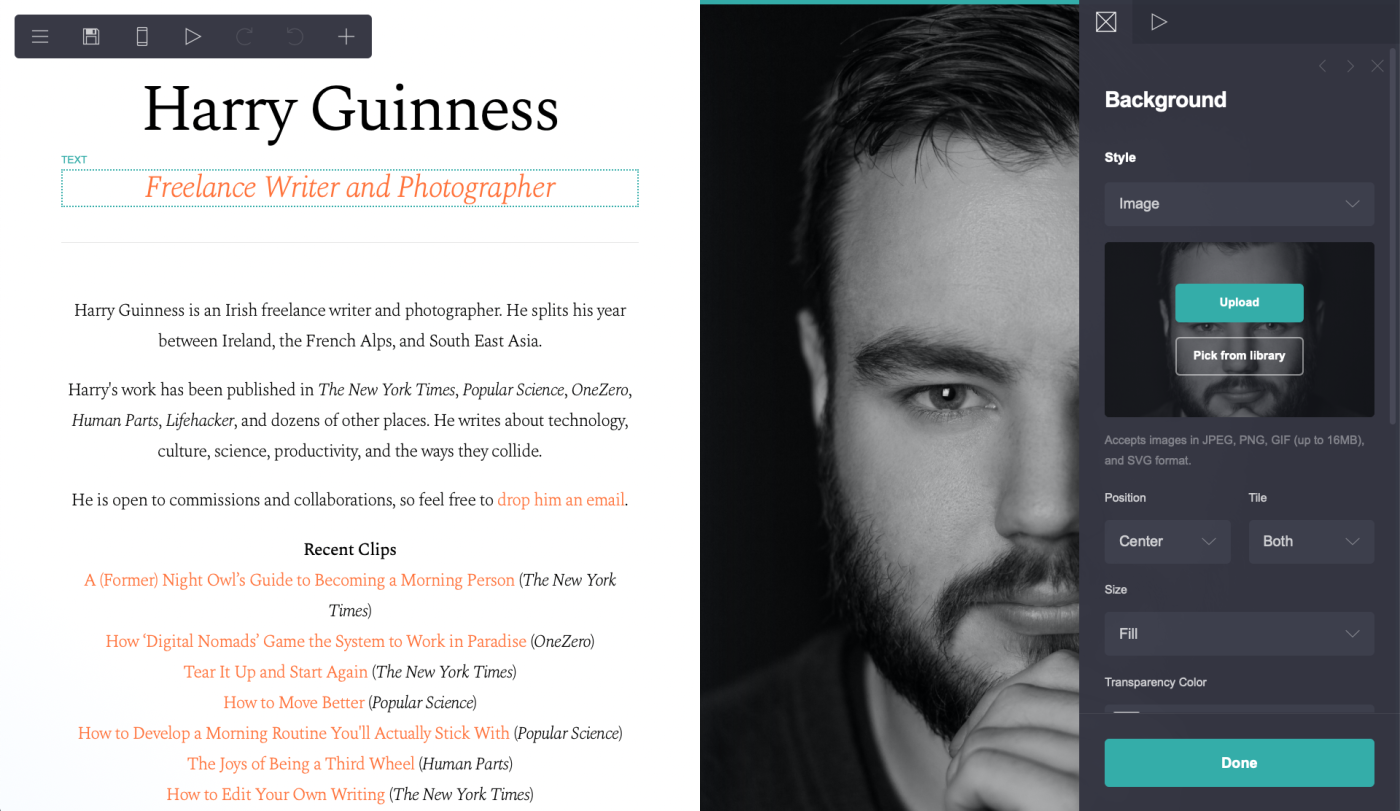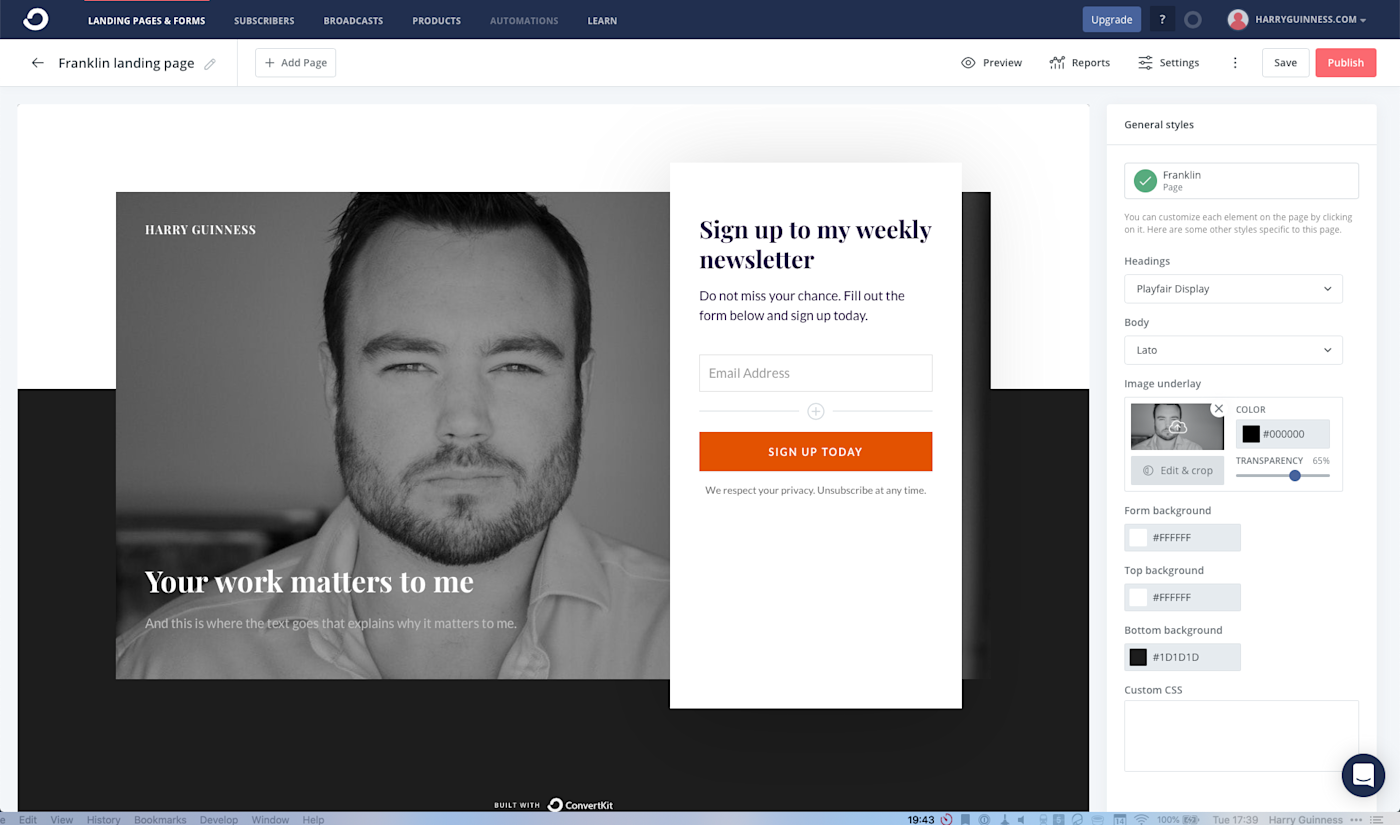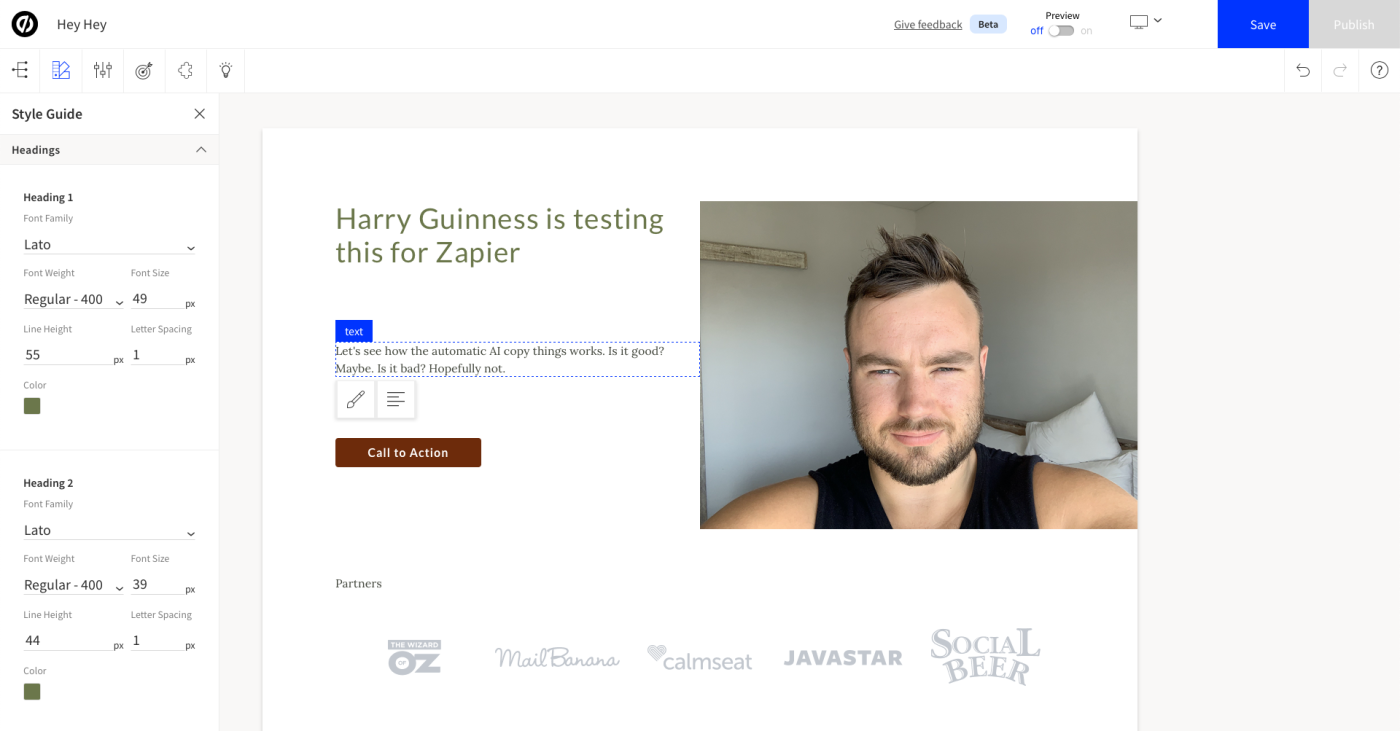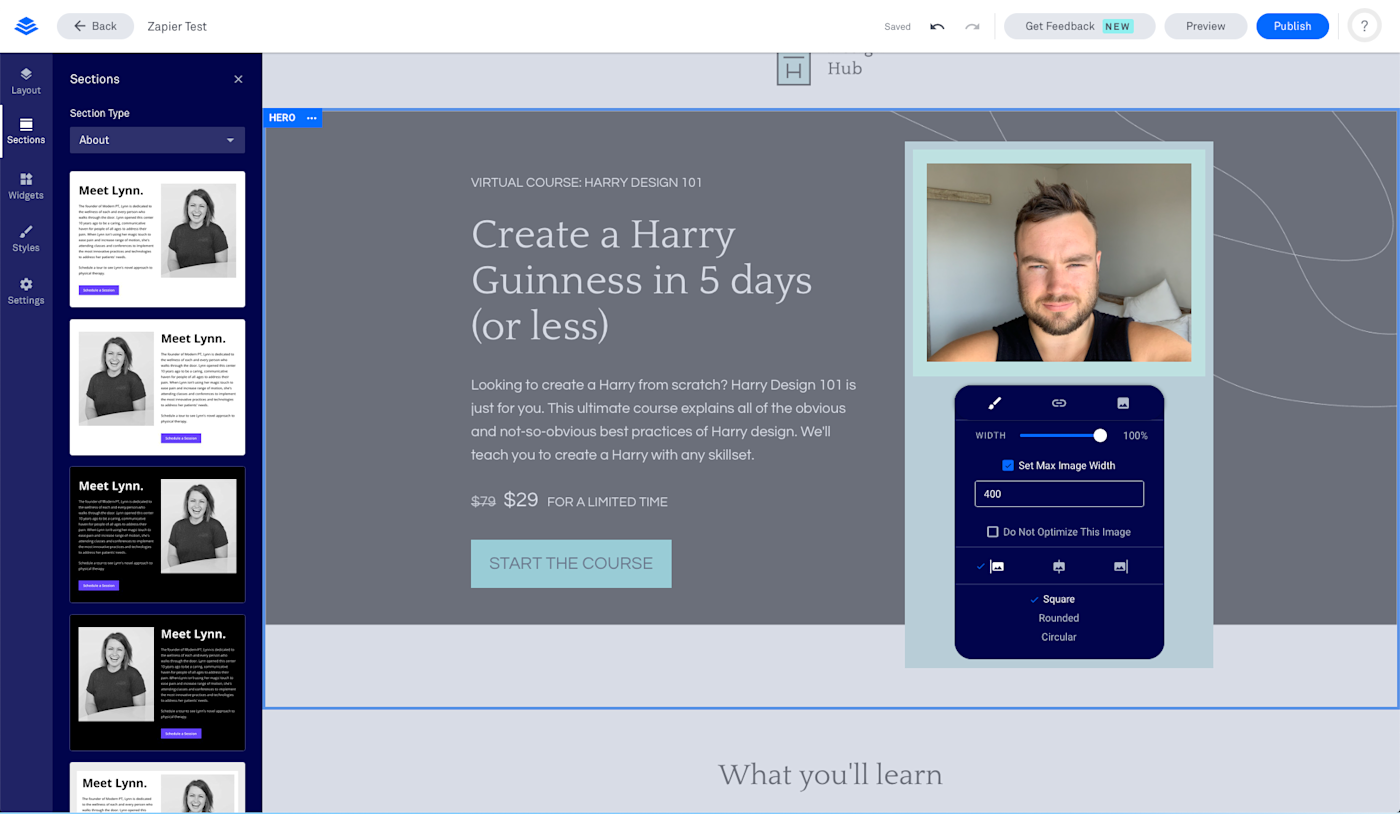How To Make A Blog Page On Wix
Landing pages are one-page websites with a specific focus. Think of them as an online business card or flyer for you or your business. You can use them to promote or sell a product or service, sign customers up to your email list, or just offer an easy way for people to reach you. I use mine to list some of my best articles.
Connect your landing page to your other apps
Landing pages can also be part of a larger marketing effort. Big brands use individual landing pages to target different sorts of customers. For example, Apple has a landing page for students that highlights their back-to-school free AirPods offer and another for business owners that showcases how different companies use their products. If you have a diverse business, you can use landing pages to similarly fine-tune your marketing efforts.
Unlike building a full website, launching a great landing page can be a quick and easy process—provided you use the right tools. With one of these landing page builders, you can do it in a matter of hours. My own website took a single evening.
The 5 best landing page builder apps
-
Carrd for making free landing pages
-
ConvertKit for driving email newsletter signups
-
KickoffLabs for competitions and giveaways
-
Unbounce for small businesses with a budget
-
Leadpages for selling products on a landing page
Some of our picks integrate with Zapier, so you can connect them to your other favorite apps and do things like automatically send form responses to your email marketing or database tool. Zapier's automations are called Zaps, and you'll see several Zap templates throughout this piece. To get started with a Zap template, just click on it, and we'll guide you through setting it up. You can read more about setting up Zaps here.
What should a landing page builder include?
The lines between landing pages, single-page websites, and even single pages on larger websites (like Apple's marketing landing pages) are blurry. In general, a good landing page tells visitors what you're offering and has a single call to action (CTA) that prompts people to join your newsletter for more information, contact you, or just purchase your product. They're a great way to capitalize on your marketing efforts by enabling you to capture leads and present targeted messages to specific audiences, like visitors from Twitter or students.
While you could hand-code your own landing page or use a CMS like WordPress, most people will do better with something simpler and more focused. To easily make great landing pages when you want to launch something new, you need:
-
An app that enables you to build one-page websites that are easy to customize without serious coding. Using CSS should be an optional extra, not required.
-
A good selection of templates for common landing page concepts. You shouldn't need to start each one from scratch.
-
A way to integrate your CTA of choice, whether you want to collect email addresses, get customers to call you, or sell your product there and then.
-
Some kind of analytics so you can track how your marketing efforts are doing.
-
The option to use a custom domain for your site.
Of course, the best landing page builders all have a lot more than five features. These are just the must-haves. With our chosen apps, as long as you have your copy written and images ready to go, you should be able to launch a landing page in 15 minutes flat. You'll also be able to edit and iterate on the fly, and with some of the more advanced apps, create two versions that get tested against each other to see what works best for marketing to your customers.
One final caveat: the best apps have to be good value for money, which means to make our list, a larger price tag had to be justified by more specific features. Some popular apps, like Instapage, missed out because they're just too expensive to recommend to most people.
After testing more than 30 apps, these are the five best landing page builders.
Best free landing page builder
Carrd (Web)

Carrd is one of the best landing page builders out there—and most of its core features are available for free. You don't even need an account to start building a page. Just head to the Carrd website, select one of the themes, and get to it. When you're ready to save or publish your site, that's when you'll need to sign up.
Carrd is really easy to get started with. Most of the editing tools are simple to use. Click an image block, and a sidebar opens where you can upload a new image and add alt text and a link. Editing text is a bit confusing since you can't edit it inline—again, you click the text then edit it in the sidebar—but it does support Markdown formatting for a quick way to customize your copy.
Many of Carrd's themes only let you move items up and down to reorder them. That's a bit restricting, but it keeps your content lined up. Or you can add a container from the + menu and set it to have multiple columns if you want to have items side-by-side. That's also how you can add more text, videos, and other items to your page.
With Carrd's free Basic plan, you can launch three sites to .carrd.co domains. It's the best way to make basic landing pages without paying a penny, though you miss out on some useful features. For example: you can't use Google Analytics; embed third-party widgets from Stripe, PayPal, and Gumroad (so you can take payments); or add forms to collect email addresses. To get more from it, you'll need to upgrade to at least a Pro Standard account. The good news is it's ridiculously affordable: plans start at just $13/year. (Full disclosure: that's what I use for my own website.)
Carrd price: Free for 3 sites with basic features; from $3/year for Pro Lite, which unlocks more templates. You need the $13/year Pro Standard plan to use advanced features like embeds, forms, custom domains, and Google Analytics.
If you want a free option that allows you to use your own custom domain, check out Google Sites. It's more limited than Carrd in many ways, but it has no paywalled features.
Best landing page builder for driving email newsletter signups
ConvertKit (Web)

If you want to use a landing page to launch an email newsletter, ConvertKit is your best option. It's designed for authors, bloggers, YouTubers, musicians, and other creators who want to monetize what they do, though it will work just as well for anyone looking to build an email list.
To start, go to Landing Pages & Forms, and click Create New. Select from one of more than 50 base templates, then add your copy and images to customize it. If you want to add more elements, like a countdown timer, feed of your past newsletters, a product people can buy, or the like, click into any element and then click the + icon that appears beside it (it took me a while to find). When you're done, you can publish using the default .ck.page domain, though it's a better idea to configure your own custom one.
ConvertKit's free plan is a good way to get started, but if you're serious about building your newsletter, you'll want to consider the Creator plan (from $29/month). It enables you to create pre-scheduled email sequences for new subscribers and integrate ConvertKit with other apps like Zapier, so you can do things like automatically add subscribers who attend an event or fill out a form.
ConvertKit Price: Free for 1,000 contacts; from $29 for the Creator plan that enables you to manage more than 1,000 contacts and adds automation features.
ConvertKit isn't the only newsletter service that offers landing pages. I also tested both GetResponse and Mailchimp (last year's pick), but I preferred ConvertKit's updated and well-designed app. However, if you already use a different email marketing tool (whether it's Mailchimp, GetResponse, or an app I haven't listed) that also has a landing page builder, I wouldn't recommend switching apps just for that. Use the landing page builder included with your existing email marketing tool.
Best landing page builder for competitions and giveaways
KickoffLabs (Web)

Sometimes you need to give people a bit of an incentive to sign up to your email list. One of the best ways to do it is with a competition or giveaway—which is where KickoffLabs comes in.
KickoffLabs is a bit more involved than some of the other apps on this list. It's not designed for quickly launching a simple landing page. Instead, you'll start by selecting the type of campaign that best matches your goal, whether it's to sign people up to a prelaunch waitlist, or offering bonus entries to a competition the more people they get to sign up. Then, pick how to gather leads: you could make a pop-up or form for an existing site, but here you'll likely want to make a landing page. You also have the option as to whether you want to run the competition on a single page, with a landing page and a pop-up box, or with a separate page.
All that's left is to pick a template and design your landing page, something that's faster than in many other landing page editors. Select text and edit it directly, or hover your mouse over the edge of the columns that divide your page and click the + button to quickly add an image, video, logo, or file download. There are also pre-made content blocks to help speed up your page design. You can then publish the page directly—or download an HTML copy of it to host on your servers for a simple way to use KickoffLabs' features with any site.
You can take it one step further by connecting KickoffLabs to Zapier, so you can do things like automatically adding new leads to your email newsletter list or database.
KickoffLabs Price: From $29/month for the Hobby plan, for 3 campaigns with up to 2,000 unique visitors per month.
Best landing page builder for small businesses with a budget
Unbounce (Web)

Many landing page builders are aimed at digital entrepreneurs and other people whose business is done mostly online. Unbounce, on the other hand, offers a lot for small, offline business owners like dentists, lawyers, and plumbers.
At $80/month for up to 500 conversions (which can be as little as people clicking on a link to your app, filling in a form, or joining your newsletter) and 20,000 unique visitors, Unbounce is only for people who are making real money from their leads. You can see how close you are to your plan's limits at the top of the screen as soon as you log in.
You can build your landing pages in one of two ways: using the drag-and-drop Classic builder, or the new AI-powered Smart Builder (though it's still technically in beta).
The Classic builder is pretty powerful: you can choose from dozens of templates that do a lot of the heavy lifting. There are even industry-specific templates for restaurants, dentists, coaches, travel guides, and other small businesses. The editor itself is one of the most powerful out there. Unlike a lot of apps, you aren't forced to place your content in aligned boxes. You can drag and drop things anywhere you want—though whether or not you should is up for debate.
The Smart Builder, on the other hand, asks you what you intend to use the page for, then automatically creates a layout based on your answers. You can then tweak things, adding extra sections or removing its suggested one as you like. There's also a built-in AI-powered copy-generating feature that suggests improvements to your headlines. It seems to work, but it's hard to tell without seeing how its suggestions do in a real marketing campaign. I also ran into a few bugs, so the Classic Builder is definitely the safer choice for now, but the Smart Builder does show promise.
Unbounce's real power, however, is in its A/B testing and targeting tools. You can create multiple variants of your page from the Variant menu in the top toolbar in the Classic Builder (in the Smart Builder, you have to add a new variant from the dashboard). Unbounce will then test them against each other to see which one gets you the most conversions. There's also an option to dynamically replace text on your page with whatever the person searched for, so you could change your headline to say "Human Resource Management Apps" or "HR Management Tools," depending on what they were looking for.
With all these features, Unbounce has a steep learning curve. So make sure you take it slow, explore all the options, and don't forget to customize all the example graphics and text—including the text in the "thank you" box after someone fills out a form.
Since you're spending a pretty penny to make it happen, you'll want to be sure you get your leads where you need them. Unbounce integrates with Zapier, so you can add your new leads to your CRM or email marketing tool. Here are a couple examples, but you can connect it to whatever app you use.
Unbounce Price: From $80/month for the Launch plan, for up to 500 conversions, 20,000 monthly visitors, and one custom domain.
Note: If you need unlimited conversions, Landingi (from $89/month) is also worth checking out, especially for marketing agencies.
Best landing page builder for selling products
Leadpages (Web)

Want a landing page where people can learn about and buy your product in one place? Leadpages has the tools you need for both. It even helps you stay focused as you're building your page. Start with a template, then click anything on the landing page design, and the rest of the page will fade out a bit so you can focus on that one thing you're editing. Each item includes a few options in a floating panel next to the item you're editing, so you can quickly change how things look. It was one of my favorite editors to work with.
Get creative with the widgets and page options in the left sidebar, where you can add videos, images, forms, and the like. You can even embed an OpenTable booking form if you run a restaurant or a Calendly form if you schedule your time that way. From the Sections menu, you can add pre-styled blocks of content such as an about section, plan pricing, or a standout call to action.
Then, with a Pro or higher plan, you can add a checkout form to your landing page. Add a Stripe account to process the payments, then drag the Checkout box from the Widgets sidebar to add a payment form to your page. It's one of the quickest ways to build a one-product store.
Plus, Leadpages integrates with Zapier, so you can do things like automatically reply to anyone who fills in a form or add them to your email marketing tool. Here are some examples.
Leadpages Price: From $37/month for the Standard plan for one site.
Could you build your own website instead?
Landing page builders are a great tool if you really just want to build a single-page marketing site with a clear CTA. But if you know you'll soon want to expand it to a full website, or even an online store, then you're better off building your own site—even if it is just a single-page one to start.
There are lots of great website building options, from the more DIY-focused, like a self-hosted WordPress install, to quick and easy-to-use template-based options that have a lot in common with the landing page builders we've just looked at, like Wix, Squarespace, and Shopify.
This article was originally published in April 2018 by Matthew Guay.
Get productivity tips delivered straight to your inbox
We'll email you 1/wk, and never share your information.
How To Make A Blog Page On Wix
Source: https://zapier.com/blog/best-landing-page-builders/
Posted by: postonthibustor.blogspot.com

0 Response to "How To Make A Blog Page On Wix"
Post a Comment